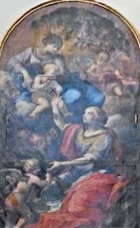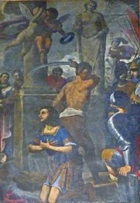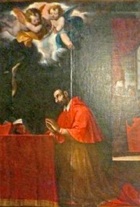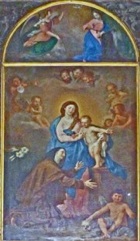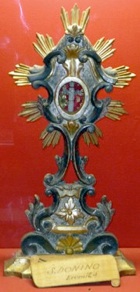

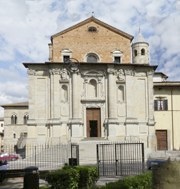
The earliest documented bishop of Città di Castello is Eubodius, in 465 AD. According to local tradition, the first Duomo of Città di Castello was dedicated as Santo Stefano. A church of this name was documented in 1360, when it was transferred from the canons of the cathedral to Bishop Buccio Bonori to make way for the extension of Palazzo Vescovile.
St Floridus is credited with building the new Duomo, which he dedicated as San Lorenzo, after the city had been devastated by Totila in the 6th century. No trace of this early church (which was presumably on this site) survives. (The dedication might reflect the previous links between St Floridus and Perugia, whose Duomo was also dedicated as San Lorenzo).
According to local tradition, Bishop Peter enlarged the Duomo in 1012, re-dedicated it as San Florido and translated the relics of St Floridus and St Amantius to its crypt (below). Three bishops are said to have attended its consecration in ca. 1032:
-
✴Bishop Andrea of Perugia;
-
✴Bishop Theobald of Arezzo; and
-
✴Bishop Theobald of Gubbio.
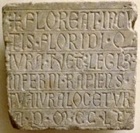
FLOREAT IN CUNCTIS FLORIDI QUI JURA TUETUR
LEGIBUS INFERNI RAPIENS TUA JURA LOCETUR
AD MCCLX7
It promises that those who follow the rights of St Floridus will flourish, while those who turn away from them will face the laws of Hell.
A number of documents in the archives of Città di Castello speak of the rediscovery of the relics of its patron saints in 1356. (A similar rediscovery of the relics of St Crescentian was made at Urbino in 1360). The authorities decided to translate them to the Altare della Confessione in the crypt (below), and to rebuild the high altar in the main church. Work on the improvement of the Duomo continued over the following decades, and the high altar was formally reconsecrated in 1445.
The Duomo was badly damaged by an earthquake in 1458, and religious fervour was further enhanced when plague struck the city in 1463. A decision was taken to rebuild the Duomo, but work was interrupted by the civil discord between the Vitelli and Giustini families. This was exacerbated by hostility between Nicolò Vitelli, the main advocate of the proposed rebuilding, and Pope Sixtus IV. The project had to wait until Nicolò Vitelli made peace with Sixtus IV in 1484. Work then proceeded at a steady pace, and the election of Giulio Vitelli (the son of Nicolò) as bishop in 1499 seems to have done much to drive the project to completion. Work was completed in 1529, and Bishop Alessandro Stefano Filodori consecrated new church as SS Florido and Amanzio in 1540. He formally recognised the relics of these saint and deposited them in a new reliquary.
In 1738, Bishop Ottavio Gasperini recognised other relics of St Floridus that are contained in a reliquary bust [in the crypt ?].
Exterior
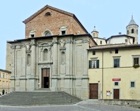
The original cupola (1680-3) by Nicolò Barbioni collapsed in the earthquake of 1789. It was reconstructed in its present form in 1790-5 by Tommaso Catrani. (The cupola can be seen in this photograph, to the left of the similar cupola of the Cappella del SS Sacramento - see below).
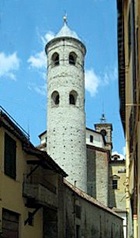
-
✴The lower part dates to ca. 1100 and has been attributed to the Aretine architect Maginardo.
-
✴The upper part was probably the subject of payments made for the reconstruction of the campanile in 1283.
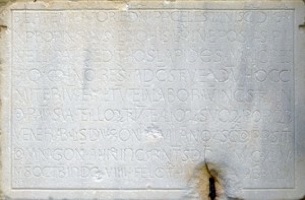
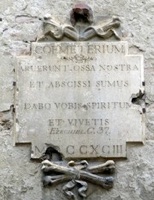
The inscription (illustrated here on the left) to the left of the portal in the left wall (see below) records the establishment of a cemetery that was established near the campanile in 1145, in memory of the recently-deceased Pope Celestine II. The present inscription in situ is dated 1793 and contains an extract from Ezekiel 37:11-14: “Our bones are dried up ... put my Spirit in you and you will live”.
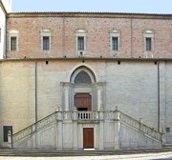
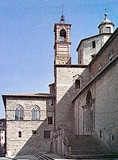
The scant survivals from the 14th century refurbishment of the Duomo include:
-
✴the second campanile, to the left of the apse; and
-
✴the Gothic portal on the left wall (below).
The steps that lead to the side portal, which flank an entrance to the crypt, were built in 1780.
Portal (1339-59)
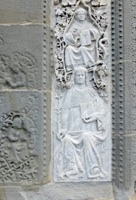
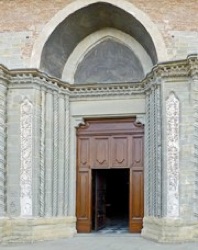
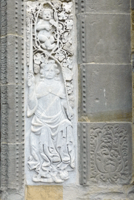
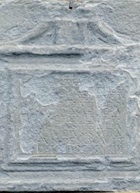
-
•The figure at the base of the panel on the left represents Mercy, with the lower of two figures of St Amantius above her.
-
•The figure at the base of the panel on the right represents Justice, with the lowest of three putti playing musical instruments above her.
The inscription to the left of the portal is described above. That to the right (illustrated here) is almost illegible, but it carries the date 1457. It seems that the decoration of the walls around the portal, which was commissioned in 1356, was subsequently halted, probably because of political problems. It was restarted in 1457 but stopped a year later following a severe earthquake.
Interior
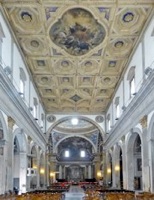
The Duomo as rebuilt in the period to 1529 had a single nave. The choir was installed in 1533-40, prior to the reconsecration of the church. The communicating chapels along the sides of the nave were added in the 16th and 17th centuries and the fine wooden ceiling was installed in 1697. As noted above, the cupola, which had been built to a design by Nicolò Barbioni in 1680-83, was rebuilt after the earthquake of 1789.
Frescoes in the Presbytery (1746-9)
The canon Giovanni Battista Manucci commissioned these frescoes from Marco Benefial in 1743, after a process that had also considered Sebastiano Conca and Francesco Mancini. He faced competition for Ludovico Mazzzanti (below), but the decision went in his favour at a meeting of the canons in 1745 after Cardinal Domenico Orsini and other members of the papal court had exerted pressure on his behalf. He arrived in the city in the following year and completed the work in March 1749: the inscription along the cornice records that the canons completed the work in that year in honour of God and SS Floridus and Amantius.
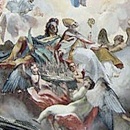
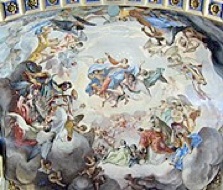
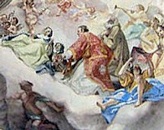
-
✴The fresco in the half vault depicts the Assumption of the Virgin and the patron saints of Città di Castello:
-
•to the left, St Floridus offers a model of the city; and
-
•to the right, St Veronica Giuliani has been inserted in tempera between St Margherita and SS Amantius and Donninus. This was presumably after her canonisation in 1839.
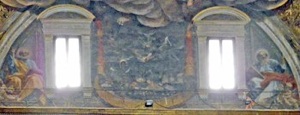
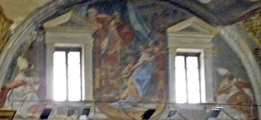
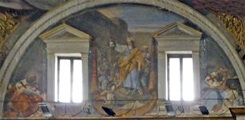
-
✴The fresco in the lunettes depict:
-
•Esther before Ahasuerus (between the windows of the right wall), flanked by two of the four Doctors of the Church;
-
•the martyrdom of St Laurence (between the windows of the back wall), flanked by SS Peter and Paul; and
-
•Judith with the head of Holofernes (between the windows of the left wall), flanked by the other two Doctors of the Church.
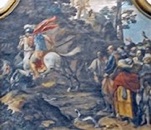
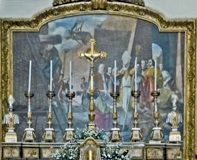
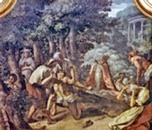
-
✴ The frescoes on the walls depict:
-
•St Crescentian killing the dragon;
-
•St Floridus rebuilding Città di Castello; and
-
•St Floridus exorcising a man possessed of a devil at Pantalla (near Todi), which is his first recorded miracle.
Cupola (1790-5)
The original cupola (1680-3) by Nicolò Barbioni collapsed in the earthquake of 1789. it was reconstructed in its present form by Tommaso Catrani.
Four Evangelists (1751)
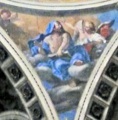
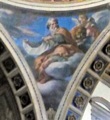
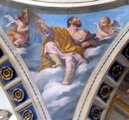
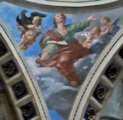
St Matthew St Mark St Luke St John
As noted above, Ludovico Mazzzanti was unsuccessful in the competition to choose the painter of the frescoes of the presbytery in 1745. He was however successful in winning the commission to fresco the cupola in 1749-51. These frescoes were mostly lost in the earthquake of 1789: only those in the pendentives survive. The designs for them are exhibited in the Museo del Duomo.
Divine Mercy (1795-7)
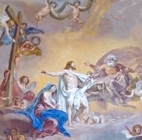
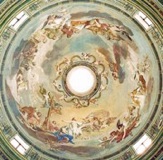
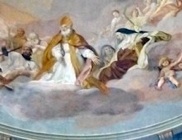
Tommaso Conca was called from Rome in 1795 to execute the fresco decoration of the rebuilt cupola. This was to be the last major project of his career. The fresco depicts Christ, the Virgin and the patron saints of Città di Castello pleading with God the Father for mercy.
Transepts
The Roman artist Ermenegildo Costantini was at work on the frescoes of the transepts at the time of the earthquake of 1789 and was lucky to escape with his life. His designs for the original work are exhibited in the Museo del Duomo.
Frescoes (1795-7)
Tommaso Conca executed the frescoes in the vaults the transepts, largely following the designs by Ermenegildo Costantini (above):
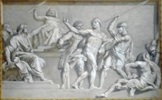
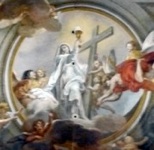
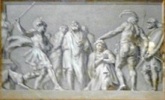
-
✴The frescoes in the vault of the left depict the triumph of Religion, flanked by chiaroscuro scenes from the life of St Crescentian:
-
•St Crescentian refuses to sacrifice to an idol; and
-
•the martyrdom of St Crescentian.
-
The fresco in the tondo between the windows depicts the bishop St Albert and his deacon, St Brictius, who were martyred in 711 AD.
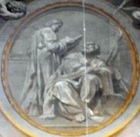
-
-
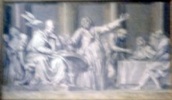
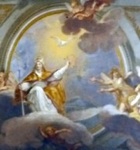
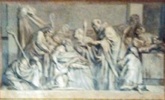
-
✴The frescoes in the vault of the right depict an allegory of the Church, flanked by chiaroscuro scenes from the life of St Floridus:
-
•St Floridus tells Pope Gregory I of the story of the martyrdom of St Herculanus, bishop of Perugia; and
-
•the bishops of Perugia, Gubbio and Arezzo attend his last Communion.
-
The fresco in the tondo between the windows depicts the Blessed Buccio Bonori, who was bishop of Città di Castello in the period 1358-74.
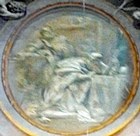
-
-
-
Mystical Marriage of St Catherine
Nave
St Floridus in Glory with Saints (1607)
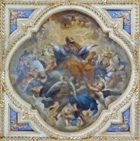
-
✴SS Amantius and Crescentian to the left; and
-
✴the Blessed Margherita of Città di Castello to the right.
Cappella di San Michele Arcangelo
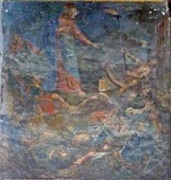
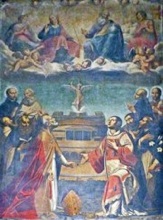
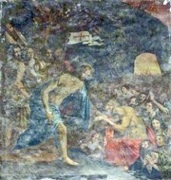
The decoration of this chapel (in the 6th bay on the right) is attributed to Giovanni Battista Pacetti, lo Sguazzino. The work comprises:
-
✴the altarpiece, which depicts:
-
•the Trinity with the Virgin and St John the Baptist (above); and
-
•SS Floridus and Amantius kneeling in a landscape, with the Castel Sant’ Angelo in the background and other saints to the sides; and
-
✴the frescoes on the walls, which depict:
-
•the capture of Christ; and
-
•Christ’s descent into limbo.
Cappella dell’ Angelo Custode
The decoration of this chapel (in the 5th bay on the right) includes:
-
✴the altarpiece (17th century) of the Virgin (above) and St Michael and Tobias (below), by Giovanni Battista Pacetti, lo Sguazzino:
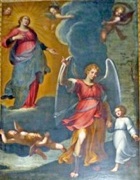
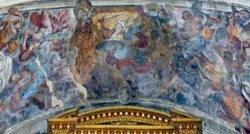
-
✴the fresco (17th century) of St Michael expelling the rebel angels in the vaults, which Girolama Bandini, (the wife of Chiappino Vitelli) commissioned, and which is attributed to Pietro Montanini; and

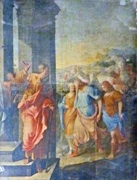
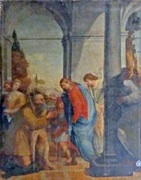
-
✴the following works (17th century) attributed to Bernardino Gagliardi:
-
•the panel above the altarpiece, which depicts God the Father and an angel;
-
•the panel on the left wall, which depicts St Michael chaining the Devil; and
-
•the panel on the right wall, which depicts St Michael and Tobias.
Cappella del SS Sacramento (1682-5)
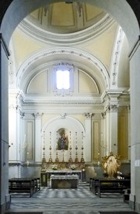
Cappella di San Crescenziano
This chapel is in the 1st bay on the right.
Martyrdom of St Crescentian (17th century)
Christ in Judgement (17th century)
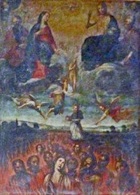
Cappella di San Carlo Borromeo
This chapel is in the 5th bay on the left.
St Charles Borromeo before a Crucifix (early 17th century)
Crucifixion with saints (17th century)
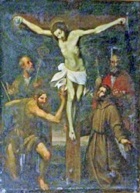
Cappella di Santa Maria del Soccorso
Bernardino Gagliardi decorated this chapel (in the 3rd bay on the left) in 1641 for the Eleosari family and the Confraternita di San Giovanni Decollato. The programme comprised:
-
✴the altarpiece known as the Madonna del Soccorso (signed by the artist and dated by inscription), in which the Virgin calms a mad woman who is trying to injure her child; and
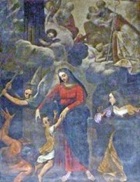
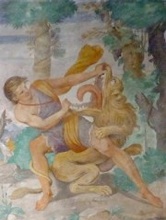
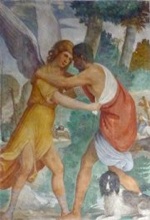
-
✴the frescoes of the chapel walls, which depict:
-
•Samson fighting a lion, on the left;
-
•Tobias and the angel, on the right;
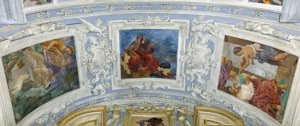
-
✴the frescoes of the vault, which depict:
-
•the sacrifice of Isaac;
-
•the Assumption of the Virgin; and
-
•David calming King Saul; and
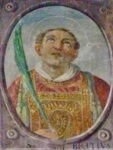

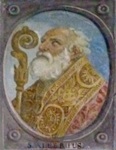
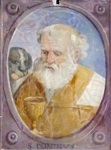
-
✴frescoes of saints in tondi in the sides of the entrance arch:
-
•SS Brictius and Ventura on the left; and
-
•SS Albert and Donninus on the right.
Cappella della SS Annunziata
This chapel (in the 2nd bay on the left) belonged to the Guazzini family.
Vision of the Blessed Veronica Giuliani (1795-7)
-
✴The main scene depicts a vision in which St Veronica sees the Madonna and Child and the young St John the Baptist in glory.
-
✴The lunette contains a depiction of the Annunciation.
Cappella di San Paolo
This chapel is in the 1st bay on the left.
Conversion of St Paul (16th century)
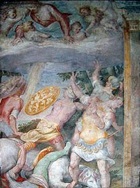
Frescoes (ca. 1675)
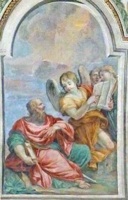
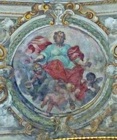
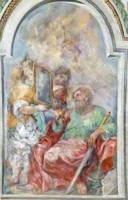
The brothers Nicolò and Annibale Longini commissioned these frescoes for the vaults of the the chapel from Pietro Montanini. They depict Christ in Glory, flanked by two scenes from the life of St Paul.
Sacristy
The sacristy, which is reached via the door in the right transept, took on its present appearance in 1749.
Risen Christ with saints (early 16th century)
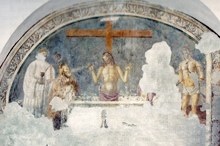
This fresco in the niche on the right depicts the Risen Christ with SS Floridus and Donninus on the right and St Sebastian and another saint (probably originally St Roch) on the right. A fragmentary inscription at the lower right reads MEN ..... PESTIS. The fresco was probably commissioned after the serious outbreak of plague in 1499.
Christ in Judgement (ca. 1630)

St Floridus (18th century)
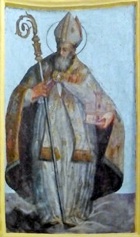
Crypt
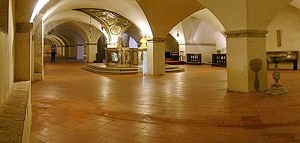
According to local tradition, Bishop Peter enlarged the Duomo in 1012 and translated the relics of SS Floridus and Amantius to its crypt. This subterranean structure was extended following the rediscovery of the relics in 1356 and took on on its present from in the 16th century.
Altare dei Corpi Santi
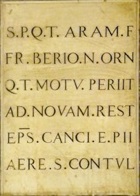
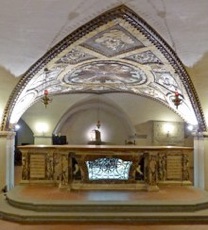
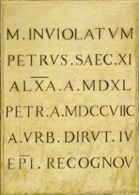
The relics of St Floridus are preserved under the Altare dei Corpi Santi, which is directly under the crossing of the church above. The inscriptions on the front of it (illustrated above) record that Bishop Peter (PETRVS) placed the relics of a number of saints here in the 11th century and that they were recognised on two subsequent occasions:
-
✴in 1540, by Bishop Alessandro Filodori (ALXA), following the rebuilding of the Duomo; and
-
✴in 1793, by Bishop Pietro Boscarini (PETR), four years after the earthquake that destroyed the original altar.
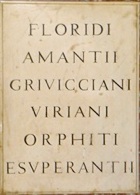
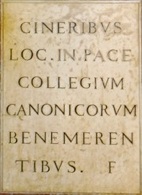
The inscriptions on the back of the altar list the saints whose relics were placed here by the canons of the Duomo: not only St Floridus and St Amantius, but also four of the so-called Martyrs of Saddi, whose relics were presumably translated here from the Pieve di Saddi:
-
✴St Grivicianus;
-
✴St Virianus;
-
✴St Orphitus; and
-
✴St Esuperantius.
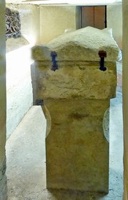
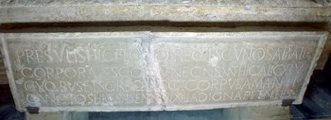
The reliquary is inside a stone sarcophagus under the altar. The inscription on the back of it reads:
PRAESULIS HIC FLORIDI REQUIESCUNT OSSA BEATI
CORPORA SANCTORUM NECNON SUNT HIC ALIORUM
CUM QUIBUS ET SANCTI REQUIESCIT CORPUS AMANTI
CUNCTOS HIC SALVENT AUXILLA DIGNA PETENTES
Here lie the blessed bones of Bishop Floridus
and the bodies of other saints
With them is the body of St Amantius
Here, all who ask shall find salvation
St Floridus (15th century)
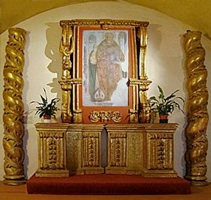
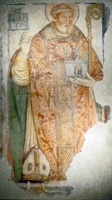
This fresco in the 1st chapel on the left was discovered under the plaster of a pilaster in the crypt in 1630. Miracles were performed here, but the Office of the Inquisition ordered that the image should be once more removed from view. However, the faithful obstructed the workers who tried to cover it with plaster, and its survival was ensured when Città di castello was spared from the plague that afflicted the surrounding area. The fresco was detached and moved to its present location in 1960.
Monument to Bishop Muzi
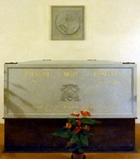
Relic of St Donninus
Relic of St Crescentian
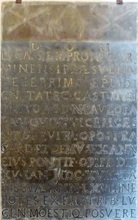
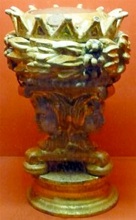
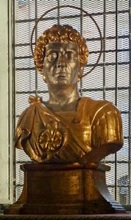
Although the body of St Crescentian was translated from the Pieve di Saddi (outside Città di Castello) to Urbino in 1068, the head remained in situ. An inscription on the right wall of the 1st chapel on the right records that Bishop Luca Semproni translated this relic to the city in 1613. In fact, this translation involved only part of the head: Bishop Evangelista Tornioli apparently translated the rest of it to the city in 1628. The chapel contains a reliquary (16th century) associated with these translations and a gilded wooden reliquary bust of the saint (now empty).
Art from the Church
Altar frontal (1144)
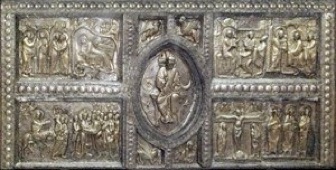
According to tradition, Pope Celestine II (who was a native of the city) presented this silver gilt altar frontal to the Duomo in 1144. The central panel depicts Christ in Glory and the symbols of the Evangelists. This is surrounded by panels depicting scenes from the life of Christ:
-
✴the Annunciation, the Visitation and the Nativity (top left);
-
✴the Adoration of the Magi and the Presentation at the Temple (top right);
-
✴the Flight to Egypt and the Capture of Christ (bottom left); and
-
✴the Crucifixion (a very early figure of the iconography of Christus Patiens) and three figures usually identified as SS Floridus, Amantius and Donninus (bottom right).
The frontal is now in the Museo del Duomo.
Triptych (1412)
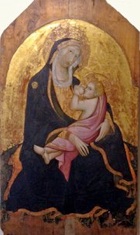

Two tempera panels survive from a triptych that the canons commissioned from Giorgio d’ Andrea di Bartolo and Giacomo di Ser Michele Castellano for a chapel in the Duomo:
-
✴The central panel of the Madonna and Child, which is attributed to the former artist, is in the Pinacoteca Comunale.
-
✴The right-hand panel of St Floridus, which is attributed to the latter artist, is in the Museo del Duomo.
The third panel, which depicted St Amantius, has been lost.
Annunciation (ca. 1504)
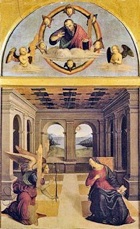
The main panel of this altarpiece, like the upper part of the Ognissanti Altarpiece above, is based on one of the predella panels of Raphael’s Oddi Altarpiece (ca. 1503).
Transfiguration (1528-30)
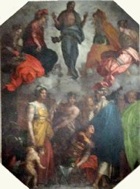
The upper part of the picture, which follows the stipulations of the original contract, depicts the Risen Christ in glory, with the Virgin and SS Anne, Mary Magdalene and Mary of Egypt. This contract added that “below ... several different figures [should be painted] to denote and represent the people". According to Giorgio Vasari, the roof fell in while Rosso was at work on this picture, damaging it and causing him to develop a high fever. He took refuge at Sansepolcro, where, "in a fury he depicted the figure of Christ ascending heavenwards flanked by four worshippers, with below them a group of people including moors, gypsies and some of the strangest beings in the world. All these figures, though perfectly executed, form a composition that was far removed from the expectations of those who had commissioned the picture". It is equally likely that the revolutionary nature of the composition was conditioned by Rosso’s during the sack of Rome in 1527.
Annunciation (ca. 1595)
This altarpiece by Nicolò Circignani, il Pomarancio in the Cappella Guazzini (the 2nd on the left) was stolen in 1809 and has never been recovered.
SS Floridus and Amantius (16th century)
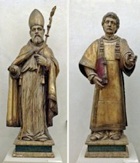
Read more:
A. Agresti, “Marco Benefial e ‘l' Affar Pittoresco’ di Città di Castello: DocumentiIInediti dal 1743-6”, Paragone, 75-6 (2007) 113-36
C. Vaiani, “La Cattedrale Tifernate e il suo Museo: Guida Storico-Artistica”, (1991) Città di Castello
Return to Monuments of Città di Castello.
Return to Walk I.
